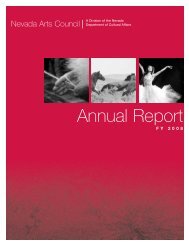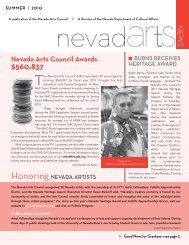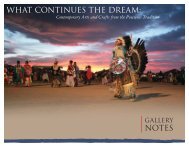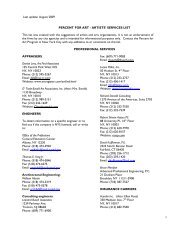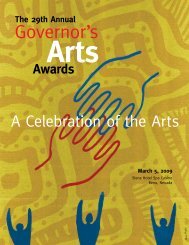Handed Down - Nevada Arts Council
Handed Down - Nevada Arts Council
Handed Down - Nevada Arts Council
Create successful ePaper yourself
Turn your PDF publications into a flip-book with our unique Google optimized e-Paper software.
1994–1995<br />
Shoshone Buckskin Tanning:<br />
Edward McDade and Lyle Sam<br />
The South Fork Te-Moak Indian Reservation at<br />
Lee, about 20 miles south of Elko, is one of the<br />
prettiest spots in <strong>Nevada</strong>. In the foothills on the west<br />
side of the Ruby Mountains, it has plenty of water and<br />
trees, good pastures, and spectacular views of the hills.<br />
Edward McDade has lived there for over 40 years,<br />
raising hay and cattle, sometimes working for other<br />
ranchers, and wondering “how the government goofed<br />
up and gave the Indians such a nice piece of ground.”<br />
Edward is one of the few practitioners of the Shoshone<br />
art of tanning and smoking buckskin, a skill he<br />
learned from his wife Florine’s grandmother and has<br />
been doing for about 15 years. He uses the hides to<br />
make work gloves that are much in demand among<br />
the South Fork ranchers. Because so few people tan<br />
their own hides anymore, there is also a big demand<br />
for smoked buckskin among women in town who make<br />
moccasins, gloves, dresses and other items, and he has<br />
no trouble selling any hides he has.<br />
into the hide and allowed to dry. The hide is then rewetted,<br />
and must be pulled and worked constantly until<br />
it is dry, soft and white, a time-consuming process that<br />
demands great patience. Edward says, “You can start<br />
in the morning, about ten o’clock, and if it’s nice and<br />
warm maybe it’ll take about four or five hours. When<br />
it starts getting stiff, you don’t have it. It ain’t going<br />
to come out no matter how hard you fight it.” In this<br />
case, the tanning must be done again, sometimes several<br />
times, before the hide is soft enough to use.<br />
Edward’s apprentice was Lyle Sam, a native of Elko,<br />
who started getting interested in the traditions of his<br />
heritage in his mid-30s. He scraped and tanned several<br />
hides, and helped Edward smoke a finished hide to give<br />
it a golden color. For smoking, the hide is folded in<br />
half and sewed together, leaving an opening so it can be<br />
hung over a smoky fire of cedar. One of the lessons Lyle<br />
learned while working with hides was to slow down.<br />
“It’s hard to slow down to do it, because I was raised in a<br />
hurry-up world, but this isn’t part of that world. You’ve<br />
got to make time for this, not hurry up and get it done.<br />
It’s not a commercialized product, it’s a traditional project<br />
where it takes time to get it done, if you’re going to<br />
do it right.”<br />
Edward speaks for all traditional artists when he<br />
says, pointing to the center of his chest, “It hits you in<br />
here, don’t it? It gets you in your heart, that’s where it<br />
comes from. Not just anybody can do it, cause you got<br />
to feel it in here.”<br />
Edward and Lyle work on scraping a deer hide.<br />
As with many traditional arts, the preparation of<br />
the materials takes at least as much time as creating the<br />
finished product. In the first place, deer hides aren’t always<br />
easy to come by, especially ones that have been<br />
carefully removed so there are no holes or tears. The<br />
hide is soaked in water for three to five days, and then<br />
scraped with a drawknife to remove all the hair and the<br />
thin layer of skin under it. The tanning process comes<br />
next, using a mixture of brains (formerly deer brains,<br />
but now more usually cow), soap and lard that is rubbed<br />
Lyle Sam and<br />
Edward McDade<br />
admire a freshly<br />
smoked hide.<br />
33






